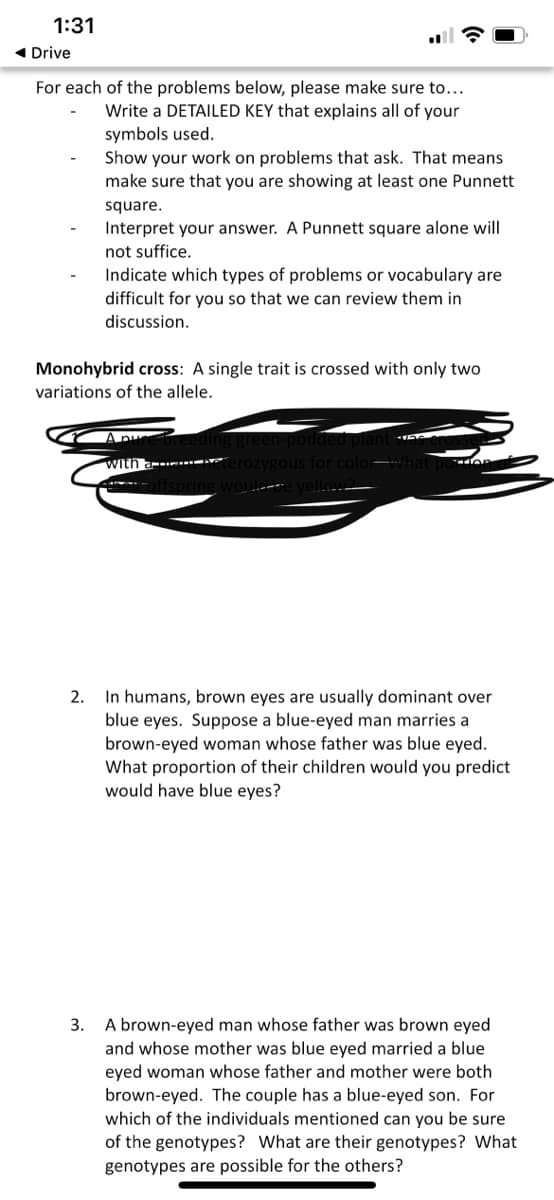2. In humans, brown eyes are usually dominant over blue eyes. Suppose a blue-eyed man marries a brown-eyed woman whose father was blue eyed. What proportion of their children would you predict would have blue eyes? 3. A brown-eyed man whose father was brown eyed and whose mother was blue eyed married a blue eyed woman whose father and mother were both brown-eyed. The couple has a blue-eyed son. For which of the individuals mentioned can you be sure of the genotypes? What are their genotypes? What genotypes are possible for the others?
2. In humans, brown eyes are usually dominant over blue eyes. Suppose a blue-eyed man marries a brown-eyed woman whose father was blue eyed. What proportion of their children would you predict would have blue eyes? 3. A brown-eyed man whose father was brown eyed and whose mother was blue eyed married a blue eyed woman whose father and mother were both brown-eyed. The couple has a blue-eyed son. For which of the individuals mentioned can you be sure of the genotypes? What are their genotypes? What genotypes are possible for the others?
Chapter6: Off To School: Cognitive And Physical Development In Middle Childhood
Section6.4: Academic Skills
Problem 5TY
Related questions
Question
100%

Transcribed Image Text:1:31
1 Drive
For each of the problems below, please make sure to...
Write a DETAILED KEY that explains all of your
symbols used.
Show your work on problems that ask. That means
make sure that you are showing at least one Punnett
square.
Interpret your answer. A Punnett square alone will
not suffice.
Indicate which types of problems or vocabulary are
difficult for you so that we can review them in
discussion.
Monohybrid cross: A single trait is crossed with only two
variations of the allele.
with
2.
In humans, brown eyes are usually dominant over
blue eyes. Suppose a blue-eyed man marries a
brown-eyed woman whose father was blue eyed.
What proportion of their children would you predict
would have blue eyes?
A brown-eyed man whose father was brown eyed
and whose mother was blue eyed married a blue
eyed woman whose father and mother were both
brown-eyed. The couple has a blue-eyed son. For
which of the individuals mentioned can you be sure
3.
of the genotypes? What are their genotypes? What
genotypes are possible for the others?
Expert Solution
Introduction:
A dominant trait only needs one allele to express, whereas a recessive trait always has to be homozygous to express itself, i.e. both copies of the gene have to be recessive.
Trending now
This is a popular solution!
Step by step
Solved in 3 steps with 2 images

Knowledge Booster
Learn more about
Need a deep-dive on the concept behind this application? Look no further. Learn more about this topic, biology and related others by exploring similar questions and additional content below.Recommended textbooks for you



Case Studies In Health Information Management
Biology
ISBN:
9781337676908
Author:
SCHNERING
Publisher:
Cengage



Case Studies In Health Information Management
Biology
ISBN:
9781337676908
Author:
SCHNERING
Publisher:
Cengage

Principles Of Radiographic Imaging: An Art And A …
Health & Nutrition
ISBN:
9781337711067
Author:
Richard R. Carlton, Arlene M. Adler, Vesna Balac
Publisher:
Cengage Learning